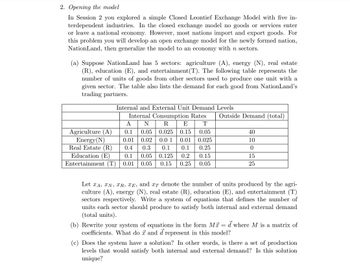
ENGR.ECONOMIC ANALYSIS
14th Edition
ISBN: 9780190931919
Author: NEWNAN
Publisher: Oxford University Press
expand_more
expand_more
format_list_bulleted
Question
Kindly correctly

Transcribed Image Text:2. Opening the model
In Session 2 you explored a simple Closed Leontief Exchange Model with five in-
terdependent industries. In the closed exchange model no goods or services enter
or leave a national economy. However, most nations import and export goods. For
this problem you will develop an open exchange model for the newly formed nation,
NationLand, then generalize the model to an economy with n sectors.
(a) Suppose NationLand has 5 sectors: agriculture (A), energy (N), real estate
(R), education (E), and entertainment (T). The following table represents the
number of units of goods from other sectors used to produce one unit with a
given sector. The table also lists the demand for each good from NationLand's
trading partners.
Internal and External Unit Demand Levels
Internal Consumption Rates
A N R E
0.1 0.05 0.025 0.15
T
0.05
Agriculture (A)
Energy (N)
Real Estate (R)
0.01 0.02 0.0 1 0.01 0.025
0.4 0.3 0.1 0.1 0.25
Education (E) 0.1 0.05 0.125 0.2 0.15
Entertainment (T) 0.01 0.05 0.15 0.25 0.05
Outside Demand (total)
40
10
0
15
25
Let A, N, R, E, and IT denote the number of units produced by the agri-
culture (A), energy (N), real estate (R), education (E), and entertainment (T)
sectors respectively. Write a system of equations that defines the number of
units each sector should produce to satisfy both internal and external demand
(total units).
(b) Rewrite your system of equations in the form M = d where M is a matrix of
coefficients. What do and d represent in this model?
(c) Does the system have a solution? In other words, is there a set of production
levels that would satisfy both internal and external demand? Is this solution
unique?
Expert Solution
This question has been solved!
Explore an expertly crafted, step-by-step solution for a thorough understanding of key concepts.
Step by stepSolved in 4 steps with 1 images

Knowledge Booster
Learn more about
Need a deep-dive on the concept behind this application? Look no further. Learn more about this topic, economics and related others by exploring similar questions and additional content below.Similar questions
Recommended textbooks for you

 Principles of Economics (12th Edition)EconomicsISBN:9780134078779Author:Karl E. Case, Ray C. Fair, Sharon E. OsterPublisher:PEARSON
Principles of Economics (12th Edition)EconomicsISBN:9780134078779Author:Karl E. Case, Ray C. Fair, Sharon E. OsterPublisher:PEARSON Engineering Economy (17th Edition)EconomicsISBN:9780134870069Author:William G. Sullivan, Elin M. Wicks, C. Patrick KoellingPublisher:PEARSON
Engineering Economy (17th Edition)EconomicsISBN:9780134870069Author:William G. Sullivan, Elin M. Wicks, C. Patrick KoellingPublisher:PEARSON Principles of Economics (MindTap Course List)EconomicsISBN:9781305585126Author:N. Gregory MankiwPublisher:Cengage Learning
Principles of Economics (MindTap Course List)EconomicsISBN:9781305585126Author:N. Gregory MankiwPublisher:Cengage Learning Managerial Economics: A Problem Solving ApproachEconomicsISBN:9781337106665Author:Luke M. Froeb, Brian T. McCann, Michael R. Ward, Mike ShorPublisher:Cengage Learning
Managerial Economics: A Problem Solving ApproachEconomicsISBN:9781337106665Author:Luke M. Froeb, Brian T. McCann, Michael R. Ward, Mike ShorPublisher:Cengage Learning Managerial Economics & Business Strategy (Mcgraw-...EconomicsISBN:9781259290619Author:Michael Baye, Jeff PrincePublisher:McGraw-Hill Education
Managerial Economics & Business Strategy (Mcgraw-...EconomicsISBN:9781259290619Author:Michael Baye, Jeff PrincePublisher:McGraw-Hill Education


Principles of Economics (12th Edition)
Economics
ISBN:9780134078779
Author:Karl E. Case, Ray C. Fair, Sharon E. Oster
Publisher:PEARSON

Engineering Economy (17th Edition)
Economics
ISBN:9780134870069
Author:William G. Sullivan, Elin M. Wicks, C. Patrick Koelling
Publisher:PEARSON

Principles of Economics (MindTap Course List)
Economics
ISBN:9781305585126
Author:N. Gregory Mankiw
Publisher:Cengage Learning

Managerial Economics: A Problem Solving Approach
Economics
ISBN:9781337106665
Author:Luke M. Froeb, Brian T. McCann, Michael R. Ward, Mike Shor
Publisher:Cengage Learning

Managerial Economics & Business Strategy (Mcgraw-...
Economics
ISBN:9781259290619
Author:Michael Baye, Jeff Prince
Publisher:McGraw-Hill Education